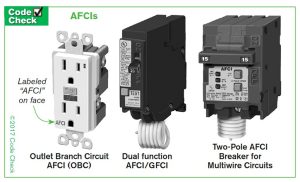As of February 1, 2022 the new TREC Standards of Practice require inspectors to report the following:
535.229 (b): Standards of Practice: Branch circuits, connected devices, and fixtures.
(C) report as Deficient:
(ii) the absence of arc-fault protection in the following locations:
Kitchens, family rooms, dining rooms, living rooms, parlors, libraries, dens, bedrooms, sunrooms, recreation rooms, closets, hallways, laundry area
What is Arc-Fault Protection and what does it mean to your buyer(s):
WHAT IS: Arc Fault Circuit Interrupters (AFCIs), aka AFCI breakers or receptacles, are an important electrical fire prevention and safety requirement of the National Electrical Code (NEC®), which first required them beginning in 1999. AFCI’s help protect individuals and families from injuries and/or death by detecting dangerous arcing in electrical wires and shutting down an electrical system, “tripping the breaker”, before a fire can start.

WHAT DOES IT MEAN: Except for most new build construction all TREC Residential Inspection reports will have this listed as a deficiency.
Our report response: AFCI (arc fault circuit interrupt) is not installed or could not be verified as specified in the Texas Real Estate Commission Standards of Practice (SOP). The SOP mandates we show this condition as “deficient” if AFCI protection is not installed in kitchens, family rooms, dining rooms living rooms, parlors, libraries, dens, bedrooms, sunrooms, recreation rooms, closets, hallways, and laundry area. Not to be confused with GFCI protection that protects from electrocution, AFCI protection is intended to prevent fires by detecting arc fault events. AFCI protection was first introduced in the 1999 National Electric Code, and at that time was limited to sleeping areas. AFCI can be problematic if installed in older homes, often causing nuisance breaker trips.
For more information on AFCI go to: https://www.afcisafety.org/afci/what-is-afci

Recent Comments